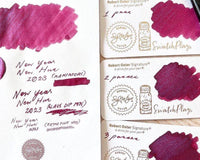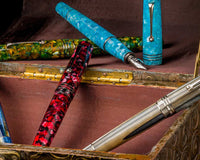Discovering fountain pens is one thing, but exploring fountain pen inks opens up another realm in the world of stationery. It isn’t just the variety of ink colors and textures that you need to know about; there are also several types of fountain pen inks with very different characteristics. Some sheen and shimmer while others stand the test of time. Certain types of ink are best for creative pursuits like calligraphy while others are designed for administrative work.
Whatever your intended use may be, there is a fountain pen ink out there for you. Here are the different types of fountain pen inks and what you need to know about them:
Dye-Based Inks
Dye-based fountain pen inks are perhaps the most well-known and widely available ones used today. They are made of water-soluble chemical components and are relatively easy to use. Aside from that, they are also quite affordable.

Another great characteristic of dye-based inks is that they are easy to clean out of fountain pens. They do not typically clog, and in the event that they do, it is easy to flush out with water. This makes it easier to experiment with various colors since they won’t stain or clog your fountain pens. Colorverse Ink Bottle (15ml) - USA Special Series is perfect for this because they generally behave really well and offer a wide color selection.
Pigment-Based Inks

Some fountain pen users may need ink bottles that are more resistant to moisture — in other words, waterproof! In this case, consider using a pigment-based fountain pen ink. These differ from dye-based inks in that they have larger particles that bind with paper once dry. Pigment-based inks are excellent for signing documents, writing letters, or filling up journals that may risk being exposed to the elements.
However, if you’re going to use something pigment-based like Platinum Ink Bottle (60ml) - Dye Ink, it is absolutely essential that you clean your pens regularly. Pigment-based inks can cause clogs that are extremely difficult to clean out. When left to dry for too long, these inks may even ruin your pens. It is also important to note that you won’t get as much variety in colors for pigment-based inks.
Iron Gall Inks

If you want ink that is even more budge-proof, then iron gall fountain pen inks like the ones from Platinum's Classic Ink line are your best bet. These inks result from the reaction of tannic acid extracted from the galls of oak trees and iron ions. The result is oxidization that results in water-insoluble and permanent fountain pen ink. These are perfect for documents that need to last, such as birth or marriage certificates and manuscripts.
It is enjoyable to write with iron gall inks because they have an attractive shading effect. However, these inks are highly acidic and, therefore, corrosive. Use iron gall inks only in fountain pens that you write with regularly. It is also important to clean your pen regularly. Fortunately, you can expect today’s iron gall ink formulas to be gentler.
Shimmer, Shading, and Sheening Inks

Last but not the least, we have shimmering, shading, and sheening inks. These are often confused with one another, so let’s differentiate them. Sheen is where ink shows two colors upon drying on paper. On the other hand, shading inks appear to fade from one end of your pen strokes to the other. Shimmering fountain pen inks are those that are infused with glitter, such as the ever-popular J Herbin 1670 Ink Bottle (50ml) - Anniversary Collection.
For sheening and shimmering fountain pen inks to appear, it is best to use low-absorption fountain pen paper to showcase its properties. Using a broad, wet nib will also allow you to get the desired results, generally speaking. It is important to flush your pens out well enough to get rid of any particles, especially when using shimmering inks.
Whether it’s the standard dye-based inks or something more permanent like iron gall, there is a fountain pen ink for everybody. All you need to know is how to use it, and the options are virtually endless. Hopefully these tips for finding the best fountain pen ink for you has been helpful in your journey.
Happy inking, and happy writing!
By Some Folks at EndlessPens







